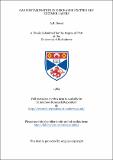Gas contamination in discharge excited XeF excimer lasers
Abstract
Infrared, ultraviolet and mass spectrometric techniques have been used to investigate the short gas-life of discharge excited XeF lasers, for He/Xe/NF3 mixtures. Infrared absorption studies provided initial information on the changes which occur in the laser gas composition during pulsing. The information was used to complement those of mass spectrometric studies, in which the chemical composition of laser gas mixtures were determined as a function of the number of laser pulses. Ultraviolet absorption spectroscopy was used to study optical absorption at the laser wavelength in fresh and used gas mixtures. The effects of several contaminants on laser performance were studied by adding small concentrations of these contaminants to the basic gas mixture of He/Xe/NF3. The results provided information on the identity of the main contaminants. Cold traps were used to extend the gas-life, and to identify dominant contaminants. The laser device used in this work is excited by a conventional blumlein circuit, which is triggered by a pressurised spark-gap switch. For a single gas fill of the basic mixture (He/Xe/NF3), the number of laser pulses to half-energy is approximately 150/litre atm. Infrared and mass spectrometric studies show that the fast deterioration of laser performance is due to the depletion of NF3, and to the accumulation of contaminants in the laser. The contaminants have been identified as N2, O2, NO, NO2, N2O, CO, CO2, NF2, N2F2, HF and CF4. Of these, NO2 absorbs at the laser wavelength (351nm), but the absorption coefficient in used gas mixtures is small compared to small signal gains of laser devices similar to the one used in this work. There is strong evidence that water vapour, which is one of the main impurities in fresh gas mixtures, may be the source of oxygen in the formation of oxides of nitrogen (NO, NO2, N2O) and carbon (CO, CO2) For fresh gas mixtures, the laser pulse energy is insensitive to the addition of small concentrations of N2, H2 and CF4. In contrast, the addition of 0.05% of CO2, CO and O2 results in approximately 60, MO and 20% reductions in the laser pulse energy respectively. The estimated change in laser output after 1000 shots due to the accumulation of CO2, O2 and CO is 20, 10 and 5% respectively. The addition of small concentrations ( < 1 torr) of N2 CO2, CO, O2 and H2 results in negligible changes in the gas-life. However, when 2 torr of CF4 is added to the basic mixture of He/Xe/NF3 a threefold increase in the gas-life is observed. The improved gas-life is attributed to lower rates of formation of O2, NO2 and NO. After using He/Xe/NF3/H2 mixtures, the gas-life of the basic mixture increased by a factor of five to about 700 shots/litre atm. Mass spectrometric analysis of the gas mixture before and after lasing shows that the improvement in the gas-life is mainly due to lower levels of O2, NO2 and NO, and to a significant reduction in the rate of depletion of NF3. The eventual deterioration of laser performance is mainly attributed to the accumulation of CO and CO2 in the laser. For the laser device and gas mixture used in this work, the optimum trap temperature lies in the region of -100 to -150°C. For a trap temperature of -150°C, the gas-life is 1500 shots/litre atm for a single gas fill. This is about 2.5 times the best result obtained without the use of cold traps. The eventual termination of laser action is due to NF3 depletion and the accumulation of contaminants in the laser. By boiling-off the contaminants sequentially, CO2 has been identified as a major contaminant.
Type
Thesis, PhD Doctor of Philosophy
Collections
Items in the St Andrews Research Repository are protected by copyright, with all rights reserved, unless otherwise indicated.

